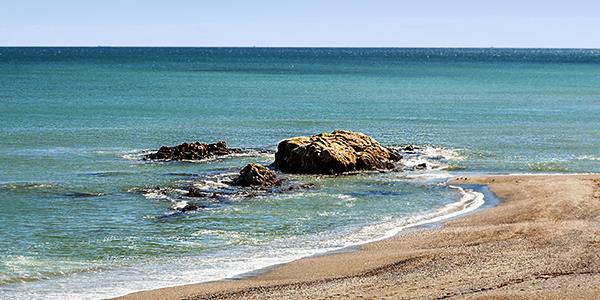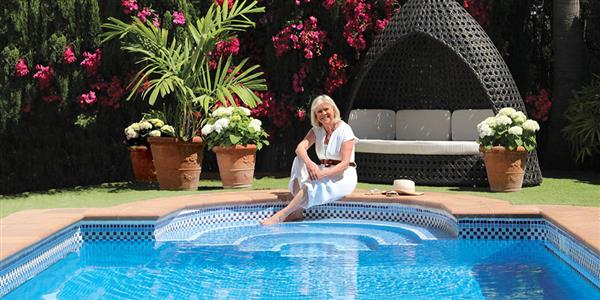
Southern Spain enjoys lovely weather for a large proportion of the year, and the Costa del Sol region has certainly earned its name!
Whether you’re visiting in the summer or the winter, there will always be plenty to see and do.
History
The town of Estepona was occupied by Moors from around the 13th century, and there is evidence of much earlier settlers, such as the Romans. In fact, remains of these previous inhabitants can be found just outside Estepona, on the way from Bena Vista, in the form of a Moorish watchtower and Roman villa. Along the A7, slightly east of Estapona the Torre de Guadalmansa was built as a watchtower, originally constructed here in the 10th century. Next to it are the remains of what would once have been a stately Roman villa.

It is likely the name ‘Estepona’ derives from Moorish influence, and the original castle was called Estebunna Castle. In the 15th century Henry IV of Castile captured the city; a church was built over the previous mosque and a new castle was constructed over the old one for coastal defence under the orders of Queen Isabella I. Parts of this new castle, the Castillo de San Luis, still stand today.
Old Town
The narrow streets of Estepona’s Centro Historico date mostly from the 18th and 19th centuries. Narrow lanes and whitewashed houses will guide you through a maze of streets. After undergoing a more recent refurbishment, the old town is largely pedestrianised, and more than 100 streets and plazas have been decorated with colours and planters.

It’s a really nice place to wander and the ruins of the 15th century castle can be found on Plaza Augusto Suárez. If you’re after a bite to eat, Calle Caridad is a long road with lots of restaurants to choose from.
There is a nice clock tower in the Plaza del Reloj that was originally part of a church built in the 15th century. And close by, on the Plaza San Francisco is the church of Santa Maria with its interesting bell tower. If you want to learn a little more about the town itself you can visit the archaeology museum in the Plaza Blas Infante. It is a pretty building that was originally the town hall.

Art and Poetry
Estapona Poetry Route is part a cultural project initiated in 2013 that sought to bring the arts to the residents of Estepona. In little plazas, on the sides of houses and mounted on various white walls as you walk the town, you will find a number of porcelain tiles with extracts from poems by local and international poets, both famous and not famous. Each is a little different; keep your eyes open for the one written in Arabic, or the one that is an extract from Shakespeare’s As you like it.
You will notice, outside of Estepona’s old quarter that a lot of the white buildings have stunning, grand murals painted on them. This too was part of an art project where local artists were given free rein to produce street art that would make locals and tourists stop and admire them.
The beach
Always a hit with holidaymakers, the coast tends to be first choice for those down in the south of Spain. The coastline around Estepona, to the east of Gibraltar, lies tucked and protected into a curve of the Alboran Sea, along the country's Mediterranean coast. One favourite beach in this area is Estepona's El Christo beach. It is a beautiful cove, set into a sheltered bay and the sands slope gently into the waters. Having previously been awarded blue flag status, this is a good one for youngsters.

It is located round the coast from Estepona's large, main beach, La Rada, so is likely to be slightly quieter (though can still get very busy in peak season). Due to its position, the protected waters are slightly warmer here than its surroundings.
On this beach you'll find fine dark sand, unlike most of the beaches along the Costa del Sol, and very little stones. The fact that it faces west towards Gibraltar means that it benefits from the most fantastic sunsets over the distant view.
Orchid House and Botanical Gardens
On the outskirts of Estepona is an interesting new botanical garden. Three glass domes house a collection of plants – mainly a variety of stunning orchid species – and is surrounded by public gardens. Inside you'll be led through displays with translation in both Spanish and English. The self-guided tour winds, over several levels, behind a large free-flowing waterfall and over a little bridge through the impressive collection of these dainty plants. The gardens are located on the Calle Terraza in Estepona, off the main ring road of the town. If you're visiting, do bear in mind the gardens are closed on a Monday.

From Bena Vista it takes just 20 minutes to get to Estepona, travelling straight down the coast road A7. There is parking towards the coast.
Find out how to stay at Bena Vista by entering your details at the bottom of the page for a free brochure.

